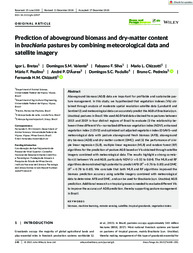Prediction of aboveground biomass and dry-matter content in brachiaria pastures by combining meteorological data and satellite imagery.
Prediction of aboveground biomass and dry-matter content in brachiaria pastures by combining meteorological data and satellite imagery.
Author(s): BRETAS, I. L.; VALENTE, D. S. M.; SILVA, F. F.; CHIZZOTTI, M. L.; PAULINO, M. F.; D’ÁUREA, A. P.; PACIULLO, D. S. C.; PEDREIRA, B. C. e; CHIZZOTTI, F. H. M.
Summary: Aboveground biomass (AGB) data are important for profitable and sustainable pasture management. In this study, we hypothesized that vegetation indexes (VIs) obtained through analysis of moderate spatial resolution satellite data (Landsat-8 and Sentinel-2) and meteorological data can accurately predict the AGB of Brachiaria (syn. Urochloa) pastures in Brazil. We used AGB field data obtained from pastures between 2015 and 2019 in four distinct regions of Brazil to evaluate (i) the relationship between three different VIs?normalized difference vegetation index (NDVI), enhanced vegetation index 2 (EVI2) and optimized soil adjusted vegetation index (OSAVI)?and meteorological data with pasture aboveground fresh biomass (AFB), aboveground dry biomass (ADB) and dry-matter content (DMC); and (ii) the performance of simple linear regression (SLR), multiple linear regression (MLR) and random forest (RF) algorithms for the prediction of pasture AGB based on VIs obtained through satellite imagery combined with meteorological data. The results highlight a strong correlation (r) between VIs and AGB, particularly NDVI (r = 0.52 to 0.84). The MLR and RF algorithms demonstrated high potential to predict AFB (R2 = 0.76 to 0.85) and DMC (R2 = 0.78 to 0.85). We conclude that both MLR and RF algorithms improved the biomass prediction accuracy using satellite imagery combined with meteorological data to determine AFB and DMC, and can be used for Brachiaria (syn. Urochloa) AGB prediction. Additional research on tropical grasses is needed to evaluate different VIs to improve the accuracy of ADB prediction, thereby supporting pasture management in Brazil.
Publication year: 2021
Types of publication: Journal article
Unit: Embrapa Dairy Cattle
Observation
Some of Embrapa's publications are published as ePub files. To read them, use or download one of the following free software options to your computer or mobile device. Android: Google Play Books; IOS: iBooks; Windows and Linux: Calibre.
Access other publications
Access the Agricultural Research Database (BDPA) to consult Embrapa's full library collection and records.
Visit Embrapa Bookstore to purchase books and other publications sold by Embrapa.

